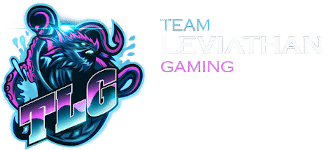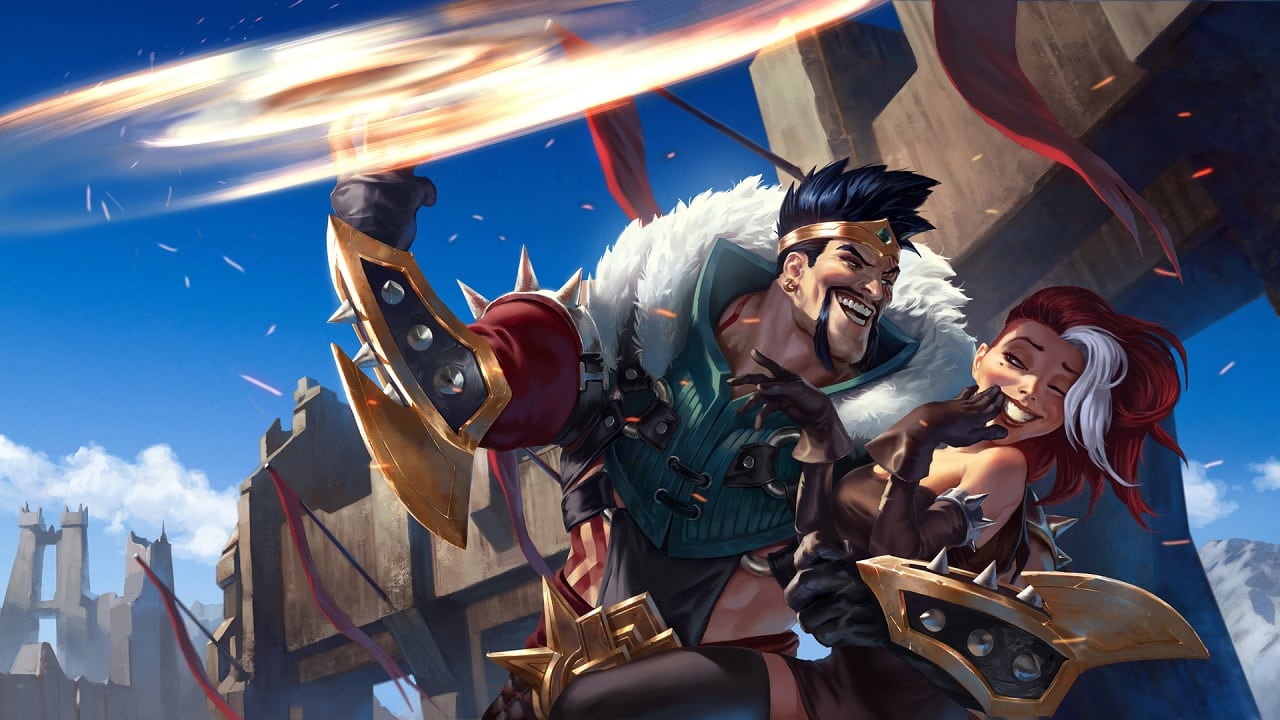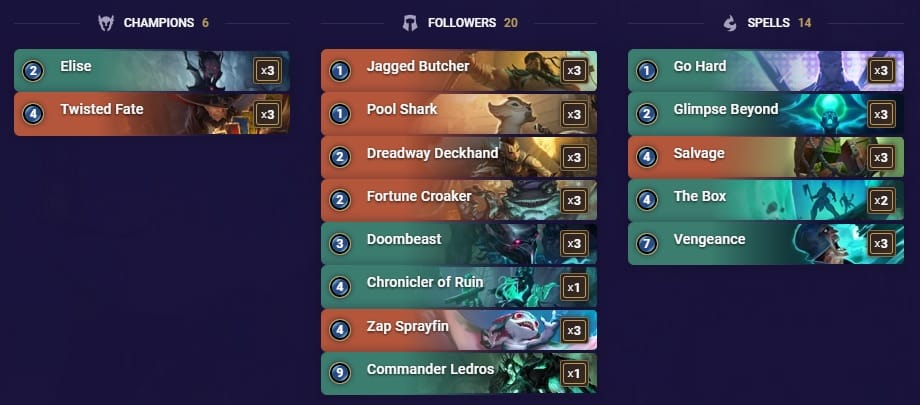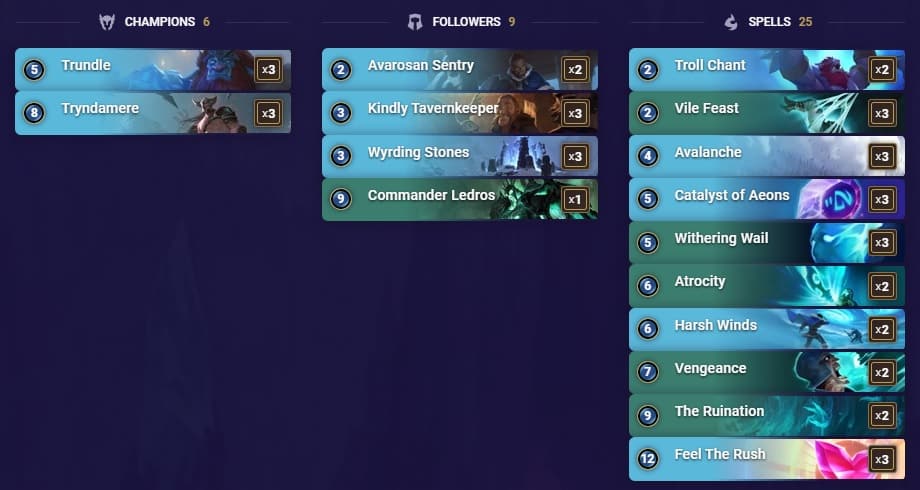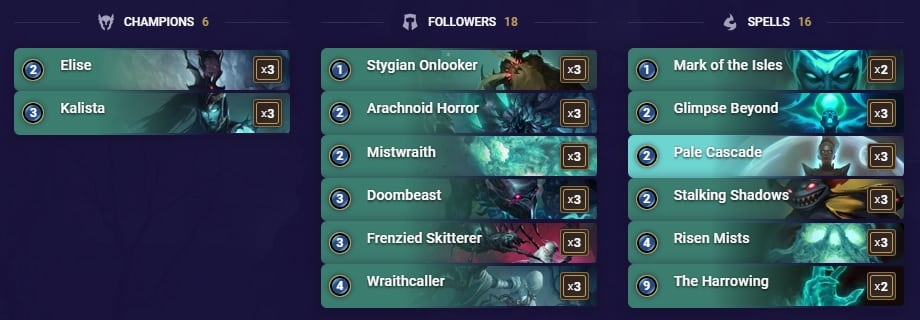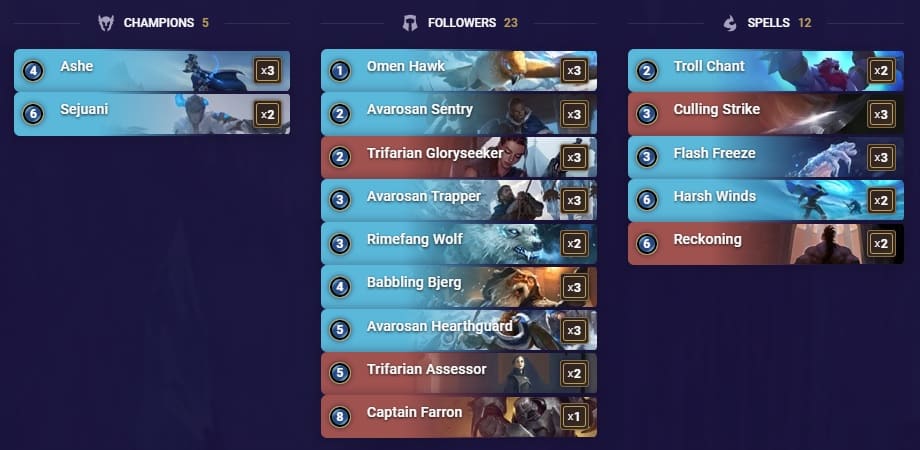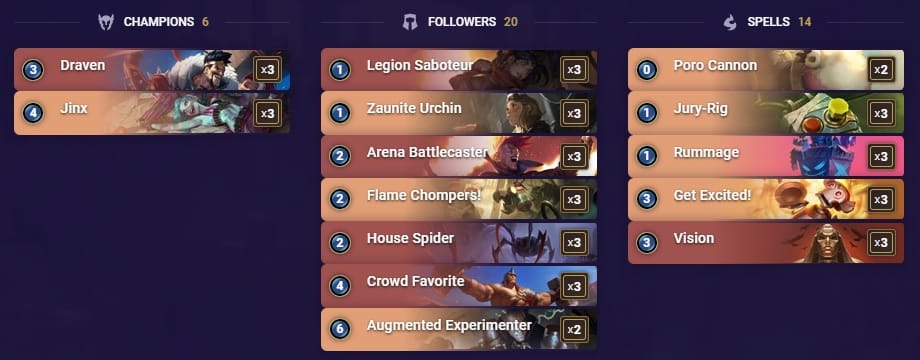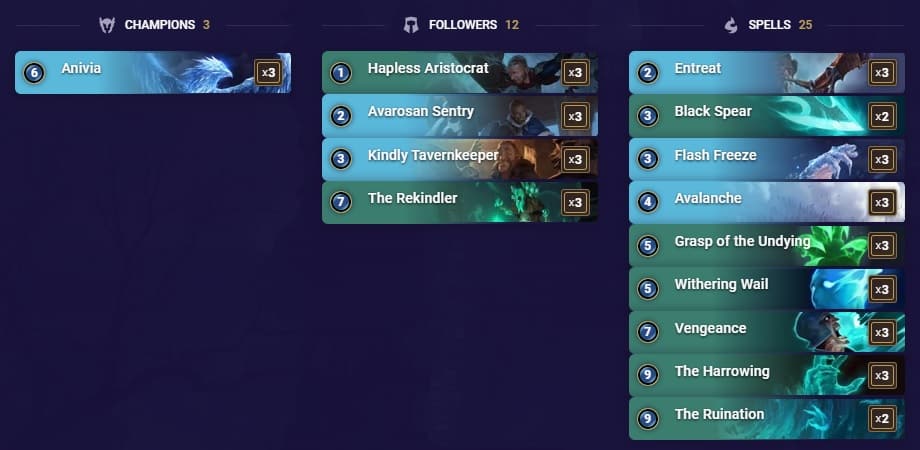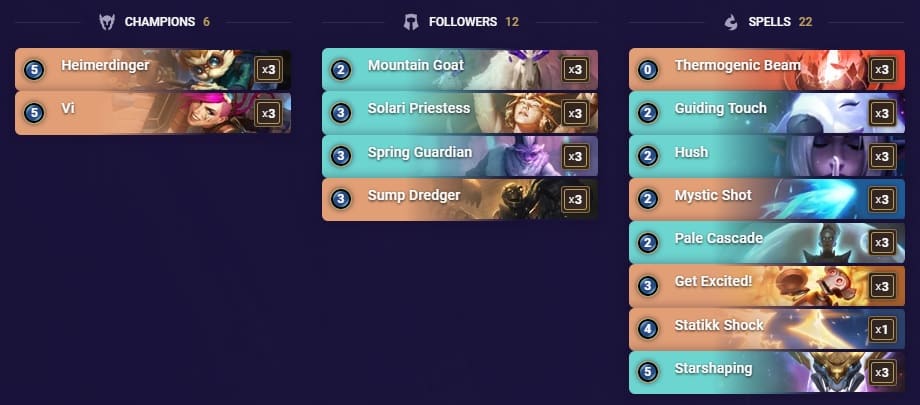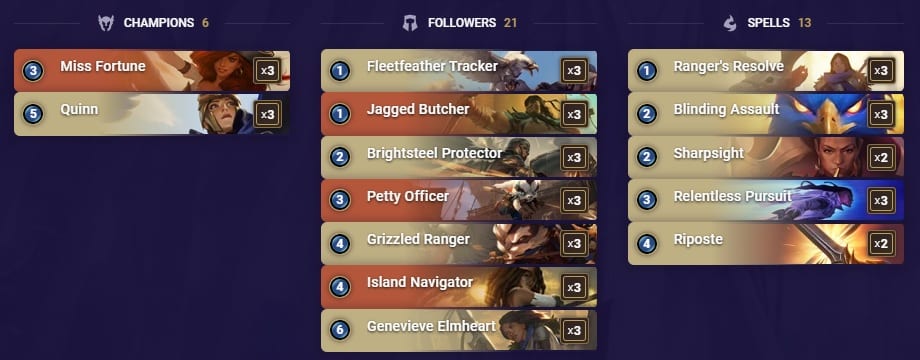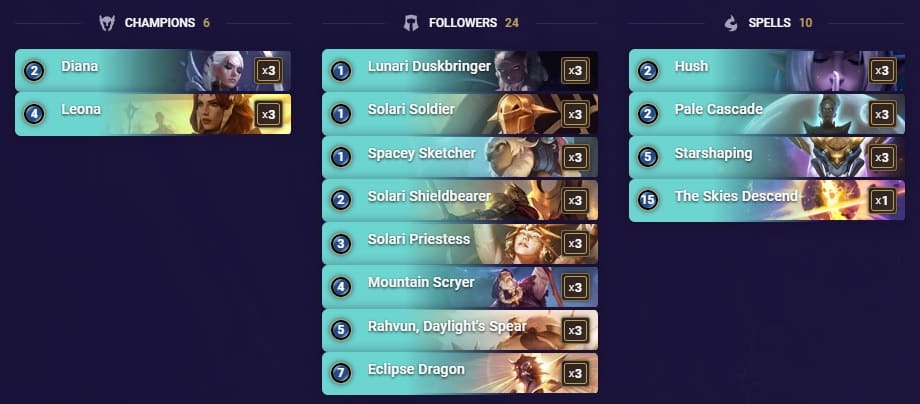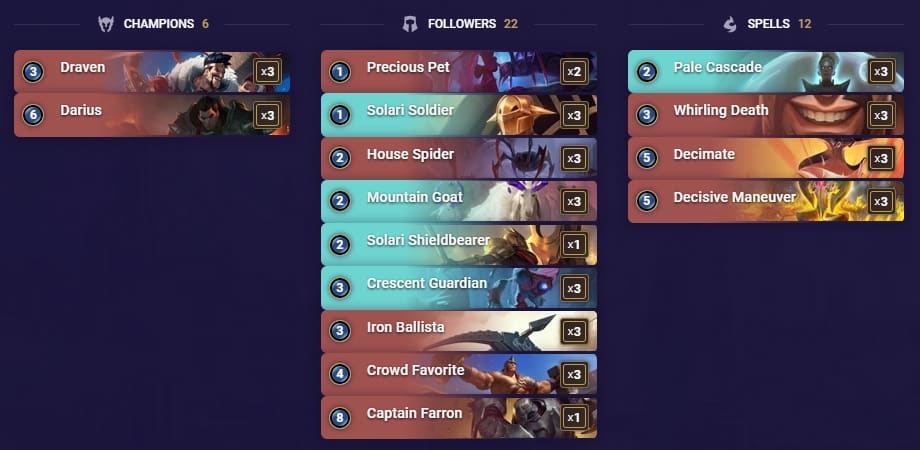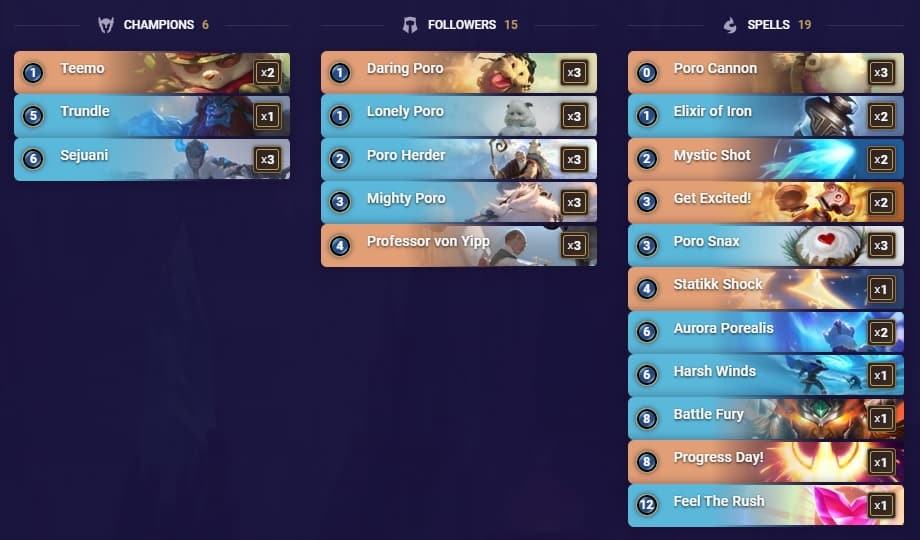Welcome to TLG’s latest meta snapshot for Legends of Runeterra, a series in which we give you our insight on the finest decks in the higher ranks of the ladder.
Every Sunday, we discuss the decks that are part of the week’s meta and rate them on a scale of 1 to 5 stars. We also look at the evolution of said decks’ ratings across weeks and draw conclusions regarding the current state of the game, all of this so you can delve into your own ranked journey with a head start.
Last week, Go Hard TF’s power level was perceived differently between NA and EU. With further testing and optimization, our consultants from both regions are convinced that Go Hard is the strongest deck in the current meta. Other than that, Feel the Rush, Mistwraith Aggro, EZ-Draven and Fiora-Shen are all looking to be the next best deck. There’s a very notable absence of Ionia decks (apart from Fiora-Shen) and Burn Aggro. Midrange decks that prioritize one-on-one combat seem to be falling out of favor.
If you have any questions, feel free to drop by our Discord. Best of luck on your climb!
Graphics: WellMax81
Editing: Crixuz, Den, Wusubi, Sebodunum, ShadowplayRed
EU Consultants: CastMin, Dartill, Kuvira, Ultraman1996, Zezetel
NA Consultants: Earlmeister, Glop, NicMakesPlays, RattlingBones, RiceFT, Stan, Zenaton

CICACAYGBABAGBIGCABQCBIBGE2QMAQGAQERUHJGHIAQCAIFCMAQEAIFEAQQ
Rating: 4.25 stars
TF-Elise can be described as a slow Burn deck, since your primary goal is to sneak in chip damage behind the enemy lines turn by turn, until Pack Your Bags and a few Doombeasts can finish the game for good. Don’t be afraid if you’re unable to swing for the enemy Nexus each turn, since this isn’t a traditional Burn deck. TF is the star of the show, proving his flexibility once again. Using Red Card alone, or combining it with Kegs, helps you get some damage in. It also provides efficient board clear, now that many of the popular decks contain smaller units that you need to deal with.
Elise is a flexible generator of early game pressure. She will create 1/1 spider tokens, which are the ideal chump blockers later on, as well as expendable targets for your Fortune Croaker. Go Hard is strong against decks that suffer from the loss of tempo that Pack Your Bags represents. Pack Your Bags costs 1 mana. Decks whose boards are wiped out by unilateral 5 damage AoE tend to be unfavoured against Go Hard - namely, Midrange lists such as Ashe-Sejuani and Scouts.
However, Go Hard is weak against decks whose value isn’t as easy to negate with 5 damage. These include Feel the Rush, Anivia and Deep - decks that employ units which are beefy enough to withstand Pack Your Bags. Morever, the nature of Go Hard is to pass priority each time a copy is played, which allows these decks to react with their own win conditions (i.e. attacking directly, casting Atrocity or The Harrowing). (Write-up by CastMin)
Additional notes: This week, we have substituted The Ruination and Crumble for Commander Ledros and The Box. Ledros can help with the matchup against the older versions of this deck, as well as against control decks. The Box is an effective answer to Mistwraith Aggro’s Wraithcaller and The Harrowing. For 4 mana, The Box counters The Harrowing and generates a huge tempo swing in your favor. As for the rationale for removing The Ruination and Crumble, Tahm-Soraka and Midrange decks have been seeing a dip in popularity.

CIBQEAIFDUUAEAYBAYLAKAIBBQKCCJZSAMAQGAICAIAQCAZKAMAQKAIPDEAQCAIFEE
Rating: 4 stars
Feel The Rush is a Freljord/SI control ramp deck. Its main win condition is to play Feel The Rush on T7 with the help of ramping tools like Wyrding Stones and Catalyst of Aeons. With the exception of Ionia lists, which have access to Deny, many decks find it very difficult to answer FTR’s huge tempo swing. Thus, if FTR resolves, the game is usually over. Atrocity is another crucial card, as it can help you to end the game one turn after FTR is played. You have strong tools at your disposal to dominate matchups with a number of decks. For example, Withering Wail will devastate Discard Aggro, and The Ruination will wreck Tahm-Soraka.
One important skill when playing Feel The Rush is banking mana so that you can play it as early as possible, or to keep yourself open in order to have enough mana for board wipes. For example, it might not be a good idea to play anything on T1 and T2 so you can play an Avalanche with no downsides on T4. Of course, a lot of this is matchup-dependent, but (as usual) being able to plan ahead will be helpful to pilot this deck well.
If possible, try to level-up Trundle before you play FTR, so that you have two Overwhelm units with 10/10 statlines to attack with. Trundle with the Overwhelm keyword can often be the difference between losing and winning. Against Aggro, it might not be a good idea to focus on ramping in order to play Trundle on T4. Instead, you want to mulligan in search of an Avalanche.
For tech cards, you can consider Grasp of the Undying or The Box if you’re facing a lot of Aggro. Both cards deal with 3 health champions (e.g. Ezreal, Kalista) easily. More importantly, they do so at Fast speed. However, we would caution against adding too many copies of Ledros, as he can brick your hand and detract from the deck’s win condition. Remember that this deck is mainly about winning with FTR summoning two 10/10 champions that are very difficult to answer. (Write-up by Crixuz)
Additional notes: Feel the Rush is becoming stronger due to the meta seeing more Ezreal-Draven and Go Hard, both of which are favourable matchups for FTR. There’s also a dearth of Ionia decks, except for Fiora-Shen.
CIBQCAYJEMCAGBIDAQDA2BYBAUHBAHRHGE2TQAICAECQGFQA
Rating: 4 stars
With Team Spain showing off a better version of Mistwraith Aggro during the EU Master’s tournament, this deck continues to reinvent itself to stay formidable in the current meta. On top of the prior addition of Pale Cascade to help with consistency and trading, Mark of the Isles has also found a spot to help with survivability against removal.
While it might seem contradictory, given that it adds +2/+2 and Ephemeral, the added stats do help with trades a lot. Moreover, making an ally Ephemeral gives you the flexibility to add potentially lethal damage to an unblocked attacker in the late game, as well as the ability to select allies to die in order to level-up a Kalista, or to make room for The Harrowing.
The deck has amazing drawing power in Pale Cascade, Glimpse Beyond and Stalking Shadows, which makes it very consistent. With all these tools, it’s hard for the opponent to exhaust this deck from a defensive position. Mistwraith Aggro is a really good deck to climb with, as it can be considered the best counter to the most popular list at the moment (Go Hard).
The Fearsome mechanic is still a powerful one in the current meta; the reliability of getting your Frenzied Skitterer with all the draw you have in the deck makes setting-up OTK boards against other board-centric decks (e.g. Tahm-Soraka) a realistic option. Risen Mists is another card that helps a lot in setting-up the OTK and surprising your opponent, as it adds a minion (that buffs other Mistwraiths) at Burst speed, ensuring that priority isn’t passed back to your opponent.
Against more defensive strategies, you can rely on a steady damage output, as bigger boards will be punished by AoE removals. The draw package will be your key to victory in such matchups, as keeping a constant refill is key. Glimpse Beyond is great here, as it not only draws two cards, but it can also deny the healing from draining spells like Grasp of the Undying. (Write-up by Den)
CIBQCAQDBEBQCAYUFY3QMAIEAEPSIJRUHIBAEAIDCYZQGAIEDMTS2AA
Rating: 4 stars
Ezreal-Draven is one of the few decks still considered as a work in progress. A lot of the others have reached their full potential, but this one is different. This is a controversial and much-discussed deck at the moment, and for a good reason, as versatility is a central component.
Relying mostly on Ezreal to close out games, the deck presents itself with tons of ways to deal with the opponent’s board and leveling-up its core champion. This aspect of the archetype performs very well against Aggro decks, as cards like Mystic Shot, Statikk Shock and Get Excited! provide significant roadblocks to the opponent’s board development. Ezreal-Draven isn’t weak against control decks, as the early minions and Draven are great ways to deal some damage that will help Captain Farron and an evolved Ezreal finish the game later on.
The huge amount of cycle gained from the PnZ region is what makes this deck so good at the moment, as it allows you to be effective on both sides of the spectrum. This is crucial to the archetype, giving you a much better chance of finding the cards you need. You can cycle the Axes from Draven and the Mushroom Clouds from Chump Whump, so you don’t have to discard any main deck cards.
This deck has myriad different ways to be built, with at least 5 or 6 prominent ones right now. The list we’re presenting here is focused on tempo and staying ahead while cycling for our good cards. Take the board early, either to slow down the opponent or to start getting some damage in. Try to evolve Ezreal while maintaining your lead and cycling your deck, before looking for the killing blow. This can be either a huge damage turn with multiple spells and Ezreal or Captain Farron simply being a huge threat while generating tons of damage in your hand.
While its Tier 1 potential is undeniable, Ezreal-Draven seems to still require a bit more refining before potentially taking over as this meta’s best deck. The archetype definitely deserves a lot of consideration though. Versatile players looking to have flexible game plans should absolutely give it a try! (Write-up by Den)
CICACAQAAEBAGAAGBYBQCARAFMYQIAIABENB2LICAEAQEEYEAEABKJJTGQAA
Rating: 4 stars
Fiora-Shen is a Midrange deck with multiple win conditions, namely through board pressure or trading four times with Fiora. Most of the game plan is trying to be the one in the driver’s seat; from there, you can decide on which specific win condition you’re aiming at. If you lose control of the game, you lose the opportunity to do this.
In order to gain this momentum, the deck is stacked with combat tricks (e.g. Sharpsight, Riposte) and ways to force combats (Single Combat, Concerted Strike) that protect your board and interact with the opponent’s even outside of the combat phase. Drawing is of course very important, and Rivershaper is the star of the show in that regard. Combined with Barriers and all the support cards in your deck, you can abuse it and cycle your deck pretty efficiently.
Relentless Pursuit is the new addition to the list, a strong card usually seen in MF Scouts. Here, it allows the player to pressure their opponent by trading with barriers and then attacking again, or to take the value trade from your Challengers when the opponent thinks it’s safe to develop their board.
Overall, this is a “do it all” archetype, which can go in different directions and allows the player to focus on various game plans. It’s important to note that the list has a tendency to lose to itself when it’s unable to get on board in the early game, as having the tempo advantage is still a key component to the deck’s success. (Write-up by Den)
Additional notes: Fiora-Shen is a well-rounded machine. It has no obvious weaknesses in the current meta and being the only deck that still runs Deny is extremely strong. It’s better than Zed-Lee, because it can “hold the door” against Aggro much better than Zed-Lee can.
CEBAIAYGAQDQQDYHAMER2IZNGM2DOVICAEBQMCICAMETYYQBAEBQSEY
Rating: NA: 4 stars, EU: 3.5 stars
As a Midrange combo deck, Tahm-Soraka wants to curve out early with its self-damage units and set-up a powerful mid game with Star Shepherd, eventually able to achieve an alternative win condition through the Star Spring landmark. By clogging up the board with units, you’re able to dictate the pace of the game.
Once you’re in control of tempo, you can focus on building towards one of your three win conditions: Star Spring, feeding Tahm and generating board presence. Having said that, it isn’t uncommon to win through the value derived from your combat tricks while Soraka draws you all the cards you need.
When it comes to problematic units from the opponent, this is where the Kench should be unbenched. Between all the heals and combat tricks, in theory Tahm Kench will be able to take out one enemy unit per turn, which by itself could be more than enough to win the game. To help Tahm in the removal department, Shakedown pulls double duty in helping to remove enemy units and damaging your own units to reach the Star Spring win condition.
Another strength of the deck is the flexibility of card choices available to you. The plethora of powerful cards available in Targon (e.g. Bastion, Broadbacked Protector) allow you to tech the deck in various ways for differing matchups. (Write-up by Zenaton)
Additional notes: Tahm-Soraka isn’t very successful in EU due to the prevalence of Mistwraith Aggro (hence the lower rating). Although the deck could never hit Tier 1 because of cards like Crumble and The Ruination, it could be a great tournament deck once you ban your bad matchups.
CIBAEAIDAQPQOAIBAEBQOFRGFEYAIAICAEBACAYBAIBACAISFIBACAZBGUAQCAIDGM
Rating: NA: 3.75 stars, EU: 3.5 stars
With efficient units and threatening combat tricks, Ashe-Sejuani is a Midrange powerhouse able to bully its way into destroying most other Midrange decks. With Freeze effects and Troll Chant winning combat engagements for you, you’ll be poised to take over the game and run it at the pace you want. Culling Strike is a strong removal spell that synergizes insanely well with Freeze, letting you deal with problematic enemy units. If your opponent tries to go wide, an early Reckoning can win the game for you, since most of your units will have 5+ power.
Trifarian Assessor allows you to take advantage of all these raw stats on your board by letting you draw enough cards to aid your search for victory. A primary finisher in the form of a leveled-up Ashe, alongside the Frostbite effects, will allow you to have one big turn where you can attack with all your units against an opposing board that won’t be able to block. (Write-up by Zenaton)
Additional notes: Ashe-Sejuani is a good deck if the meta allows it to engage in one-on-one combat. However, the meta is no longer board-centric and hence the deck is slowly falling out of favor.
CIBAMAIDA4ERIJZIG4DACBABBQOCOKBNAIAQCBANAEBQIEQA
Rating: NA: 3.75 stars, EU: 3.5 stars
Fast & Furious, this deck doesn’t have the time to play around. Throw away your whole hand, take advantage of the freebies on your Discard-based cards and hope for the best. With Draven as Dominic Toretto and Jinx as Leticia Ortiz, call your friends and start the race. Vision serves as the nitro in your engine, get some and you’ll power up your cards. This deck is hit-or-miss, so get ready for quick wins and devastating defeats.
Discard Aggro is seeing a lot of play and can succeed on ladder due to SI control decks not being as popular as they used to be. However, the list struggles against Go Hard and EZ-Draven, which prevents it from achieving a higher rating. This is also a deck where the draws can have a greater effect on the game than the player’s own skill. (Write-up by Ultraman 1996)
CIBAMAIBAEBRIGA5GIDACBIBAMKB2KZWAEBACBIPEIAA
Rating: 3.5 stars
Anivia, true to her nature, is making a comeback into the game. By herself, Anivia is already extremely hard to deal with, but with the support of The Rekindler and The Harrowing, she’ll get resurrected over and over with multiple copies on the board.
So, why are Anivia decks seeing play again? First off, with Deny disappearing from the meta, she’s poised to perform quite well. Also, with board-centric decks becoming more popular, Anivia decks are strengthened, as they should be able to stall against such decks easily while setting up a board-wipe-aplenty late game. Along with the absence of Deny, Obliterate effects are also scarce at the moment, which further suits Anivia given her resurrection focus.
The deck plays Anivia as the only champion, which allows us to draw her from playing Entreat. Apart from Entreat doing the obvious job of allowing us to find Anivia in the first place, it also has a role of supplying Anivia’s Harsh Winds to devastate any high attack units in the late game.
As you have access to the great late game of multiple Anivias, your main goal in the early game is to slow your opponent down so you can actually reach the later stages. With all the healing and AoE the deck packs in, you should be able to dominate any Aggro deck. Then, once you’re able to start stabilizing with a T6 Anivia into a potential T7 The Rekindler, you’re well-positioned to win the game with a big The Harrowing. (Write-up by Zenaton)
CIBQCAQEBACQCBA3EYTTIOAHAMESGM2QKRKVYYAAAEAQCBA7
Rating: 3.5 stars
Heimer-Vi is very much underplayed for its power level. It’s a Midrange/control archetype that can either use the Piltover tools to seize tempo or the Targon package to generate value. These regions work great together, as both can be used for pushing damage or for slowing down the opponent, giving the pilot a lot of freedom.
Thanks to units like Mountain Goat, Sump Dredger or Spring Guardian, Heimer-Vi can survive the early game. Healing cards, especially Starshaping, are crucial in providing extra survivability. Your aim should be to transfer safely to the mid game where you can start developing the real threats. Vi is often the star of that phase, being able to contain the opposing board while also representing a big threat to the opponent’s health count. A well-timed Heimer which the opponent cannot answer will put you in a favorable position.
The late game is where the Invoked Celestial cards come in, helping the deck avoid running out of steam. Combined with the value Heimer can generate, it gives what looks like a Midrange tempo deck a lot of firepower in the later stages of the game. The damage cards from Piltover can now be used to finish the game and Targon’s support cards (e.g. Guiding Touch) serve as fast cycle to keep the pressure up. (Write-up by Den)

CIBQGAIABEKR2BACAYEBMOR6AUBAAAQGA4EQUAQBAEACKAIDAAHAA
Rating: 3.25 stars
MF Scouts is a deck that relies on snowballing through two attacks per turn, creating a tempo advantage the opponent cannot hope to compete with. This could be a Miss Fortune that stays on the board and evolves, a well-timed Relentless Pursuit to deal a lot of damage or simply overwhelming the opponent and buffing our board with Genevieve Elmheart.
The meta currently features Ezreal and TF as two popular heroes, and the decks they’re used in include a variety of ways to deny tempo to their opponent. Whether it’s the Piltover package with Mystic Shot, Thermogenic Beam and Get Excited! or Go Hard being cycled until it can be a devastating board clear, these all make Scouts quiver in fear.
Scouts don’t have it easy when it comes to setting up a board they can abuse in the late game. In addition to that, other control builds like Tahm-Soraka or Anivia also gained popularity, giving yet another challenge to Scouts’ aim of dominating the board. Overall, the deck is still at a very good raw power level and it could compete as a top 3 tempo deck. The problem the archetype faces is the more defensive meta that’s now evolving. (Write-up by Den)
Additional notes: The deck is falling out of favor because it has no more good matchups to abuse (e.g Zed-Lee) while it loses to two of the best decks right now (Go Hard and Ezreal-Draven).

CEAQ2AYJDIOCGNRYJFGFIVKWLBQGIAABAEBQSAQ
With the huge buff to Eclipse Dragon, the Invoke archetype now has some proper Midrange staying power and has become a menacing deck. It’s well-positioned against some of the best meta decks, being able to Obliterate cards such as Tryndamere and Anivia, which nullifies their Last Breath effects. The key to the deck is to Invoke Celestials and play them at a reduced cost either via Mountain Scryer or Eclipse Dragon.
Since there’s a wide range of options when playing this deck due to the Invoke mechanic, it’ll take some practice to understand which Celestials are the ideal pick for each situation. Generally speaking, Falling Comet is a good pickup against most Midrange and control decks, The Golden Sister will help against Aggro, and The Traveler can help you accrue value. When you have 1 or 2 Mountain Scryers down, Written in Stars lets you grab a cheap buffed up champion for very little cost. This might help you with removing a key Ezreal through Diana’s Challenger or to stop some Fearsome units with Leona.
A quick combo idea in this list is using Lunari Duskbringer’s Duskpetal Dust to reduce Eclipse Dragon’s cost and play it on T6. This is especially effective if you have a Rahvun, Daylight’s Spear down on T5, because the Eclipse Dragon will Daybreak and Nightfall, meaning if you generate The Great Beyond with your Eclipse Dragon, you can play it on T7. (Write-up by GlopNA)
CIBQCAQDAUCAGCJDLBMVYBYBAMBASCYNCQTDOAIBAEBQ6AQBAEBTGAIDBEOA
Darius-Draven focuses on taking advantage of Overwhelm. Although you might suspect that this deck only goes tall, it actually has an easy time going wide with low-cost units like House Spider. Being able to go wide strengthens your Decisive Maneuver and Crowd Favorite. It definitely isn’t a straightforward Aggro deck, as it features both Daybreak and Nightfall units.
The most difficult aspect of piloting this deck is figuring out an efficient way to enable Crescent Guardian. For Nightfall, you can keep Draven in hand to generate Axes, which can proc Nightfall at Burst speed. The list includes three copies of Whirling Death, and can generate more if you draw multiple Dravens. Use them to take over the board and snowball with your tempo.
It wouldn’t be wrong to describe this list as a Decimate deck in unit form. Decimate deals 4 damage to the opponent’s face, but this deck runs so many 4 attack Overwhelm units like Iron Ballista, Crescent Guardian and Crowd Favorite that the entire list is essentially just a walking version of Decimate. This applies a lot of pressure on the opponent because these units demand to be answered. Chump blockers cower in fear of these Overwhelm units, as most of the damage will go through regardless.
Another aspect that separates good Darius-Draven players from the rest is the ability to make the judgement to go ahead with playing Crescent Guardian without being able to proc its Nightfall ability. After all, this is an Aggro deck that wants to be closing the game as fast as it can. But if the deck needs to go the distance, Captain Farron will save the day. (Write-up by Crixuz)
CICACAQBAIAQGBASAIAQIFAXAQAQCCAQDE2QGAIBAECACAQBAMBQCBAIE42AGAQBAECSUAQBAQPTCAQDAEDBM
Pick up Poros Midrange if you enjoy playing a Poro archetype while outvaluing the opponent. The list generates a ton of value by playing Poros together with Professor von Yipp, who gives +2/+2 to every Poro you play, which is terrifying when paired with Poro Cannon. To that end, you should only play the Professor when you know he can stay alive while you deploy multiple Poros. In a way, it isn’t that different from Heimer-Vi, where Heimer needs to be protected while you play spells.
This deck has a lot of versatility, as well as survivability in the form of Poro Snax. Midrange decks are usually plagued by the lack of card draw, but with cards like Aurora Porealis, Progress Day! and Poro Herder, it’s a breeze to refill your hand. Poros Midrange also runs one copy of Feel the Rush, mainly because we can all agree that nothing is more terrifying than a 10/10 Elusive Teemo.
Speaking of Elusives, this deck is obviously able to deal direct Nexus damage thanks to the inclusion of cards with the Elusive and Overwhelm keywords. As usual, depending on the matchup, you want to mulligan differently. Some matchups will force you to emphasize one keyword over the other - certain decks are vulnerable to Elusives while others succumb to Overwhelm. (Deck by J01, write-up by Crixuz)
